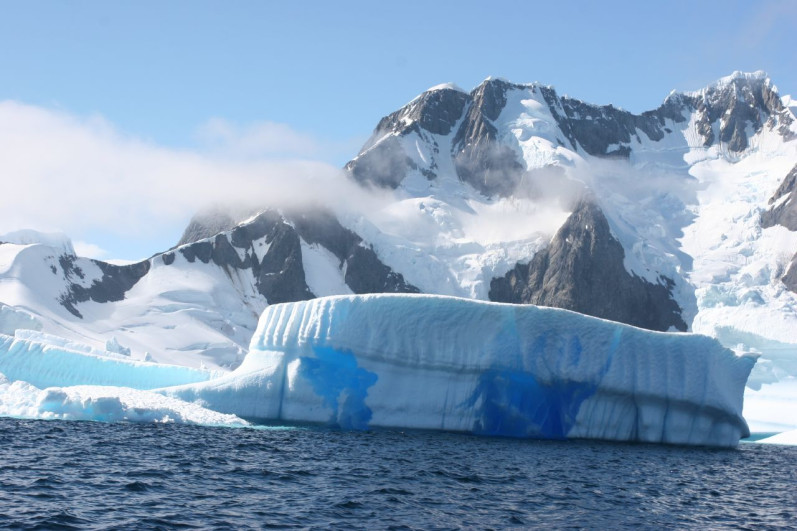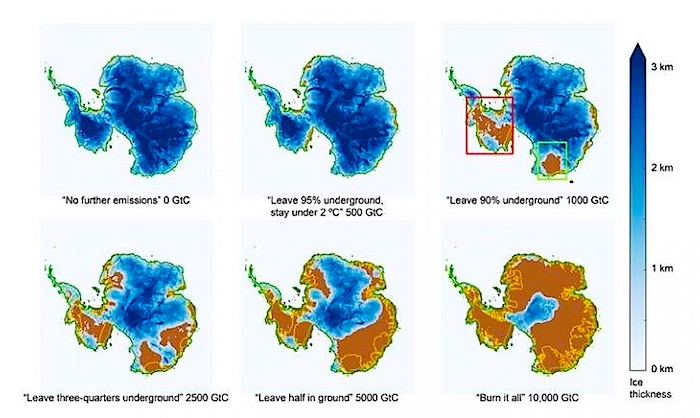
Seas could rise much faster than previously thought – nearly three meters every century for 10,000 years, if we continue our business-as-usual rate of burning fossil fuels.
New simulations of the future impact of climate change have revealed a much speeded up rate of sea level rise – by about ten-fold.
New information about the rate at which Antarctica is melting has caused scientists to revise their estimates.
Until very recently, scientists assumed that it would be impossible for the massive ice sheets of Antarctica to substantially melt — or at least, that that would take thousands of years before temperature rise was high enough to begin to melt them.
Image credit: Riccarda Winkelmann and Ken Caldeira
But new simulations published at Science Advances in September of 2015 suggest that rather than this melt being in the far future, Antarctica could begin to contribute to sea level rise as soon as the present century. The effect means that this sea level rise will begin in this century.
One author of the paper, Riccarda Winkelmann at the Potsdam Institute for Climate Impact Research told Scientific American that emitting greenhouse gases within just a few decades triggers changes that will be felt by many generations to come, and in the worst case could entirely melt Antarctica.
“Humanity can indeed melt all of Antarctica’s ice, if we were to burn all of the fossil fuels,” she said.
Arctic sea ice has been much studied, but Winkelmann and climate scientist Ken Caldeira of the Carnegie Institution for Science at Stanford University teamed up to lead an exploration of the long-term effects of carbon combustion on the earth’s other icy pole.
They used a computer model developed by Andy Ridgwell of the University of Bristol to simulate how the atmosphere and ocean respond to increasing levels of greenhouse gases.
Then they fed rising temperatures generated from rising CO2 levels into an ice sheet model developed by Anders Levermann of Potsdam University. The model showed how ice will flow and dwindle as it melts in response to temperature changes in the atmosphere and ocean, along with increased snowfall as a resulting from the increased warming or the additional melting as glaciers dwindle.
The researchers then modeled different emissions scenarios.
The world’s current annual rate of carbon emissions is about 10 billion metric tons; nearly 10 gigatons that are added to the atmosphere every year.
They looked at the effects of different possibilities, ranging from another decade of emitting carbon at the current 93 gigatons per decade rate, to a high of 12,000 gigatons as if the world were to combust all the carbon available from already discovered and recoverable deposits of coal, oil and natural gas over the next few centuries.
If, rather than switch to safe clean energy, we were to combust all the carbon now known, over the next few centuries, then the seas would rise three meters, or about 9 feet every century, rising to 50 meters or 164 feet within the next 10,000 years.
For perspective on 10,000 years of our civilization…
Image credit: Jordan Archeological Museum via Wikipedia
It was about 10,000 years ago that someone in ancient Mesopotamia made this statue that is believed to be the oldest statue in the world, when human civilization was in its earliest beginnings with the invention of agriculture.
Of course, 164 foot seas would put an end to any hope of any kind of seawall holding back an ever rising ocean from New York, Hong Kong, London, Hamburg, Shanghai and hundreds of other current centers of civilization. Many of the world’s great cities go back half a thousand years or more.
Caldeira has also studied geo-engineering but sees no solution there: “Ice sheets, once they go, are hard to get back.”

